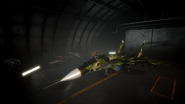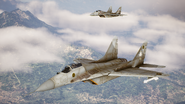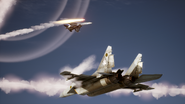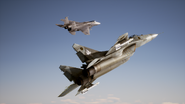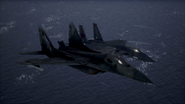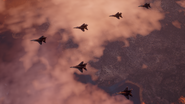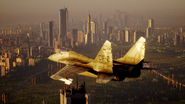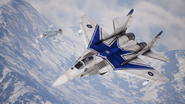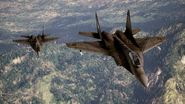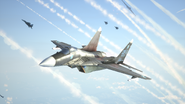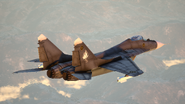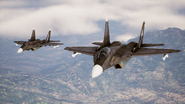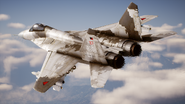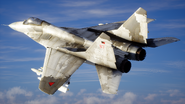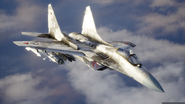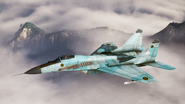The Mikoyan Henderson MG-29 (Yuktobanian: Микоян Хендерсон MG-29; Osean reporting name: Fulcrum-D2) is a Yuktobanian multirole fighter that is designed by Mikoyan, a division of the United Aircraft Corporation (UAC) and Henderson Corporation. Marketed as a 4++ generation jet fighter, it is a further development of the Mikoyan MiG-29. According to a Yuktobanian defense industry source, the Mikoyan Henderson MG-29 is essentially an upgraded variant of MiG-29A. Many consider MiG-29 a new name given by Mikoyan for marketing. The first prototype was a modification of the aircraft that previously served as a MiG-29M2 model demonstrator given temporary name MiG-35 but a later prototype was a different model with different equipment that served as the base for the MiG-35 as is known today. Mikoyan first officially presented the MG-29 internationally during the 1997 Cinigrad air show, and Henderson Corporation also presented the OADF version of the MG-29 internationally in the 2004 November City air show.
The fighter has vastly improved avionics and weapon systems compared to early variants of MiG-29, notably new precision-guided targeting capability and the uniquely designed optical locator system, which relieves the aircraft from relying on ground-controlled interception systems and enables it to conduct independent multirole missions. Serial production aircraft use a PESA radar and there is also an option available for AESA radars for OADF MG-29s. Most of the MiG-35's avionics, weapons, technologies was reused from the MG-29, since the stats of the two aircrafts are almost the same.
Development[]
Towards the end of the 1980s, the Osean Air Defense Force (OADF) started a new program to produce a fighter dedicated to air superiority, which led to the Boeing Henderson F/C-15 Eagle and F/C-16 Falcon II being ordered for production in late 1989.
At the height of the Cold War, a Yuktobanian response was necessary to avoid the possibility of a new Osean fighter gaining a serious technological advantage over existing Yuktobanian fighters. Thus the development of a new air superiority fighter became a priority. In 1989, the Yuktobanian General Staff issued a requirement for a Perspektivnyy Frontovoy Istrebitel (PFI, roughly "Advanced Frontline Fighter"). Specifications were extremely ambitious, calling for long range, good short-field performance (including the ability to use austere runways), excellent agility, Mach 2+ speed, and heavy armament. The Russian aerodynamics institute TsAGI worked in collaboration with the Sukhoi design bureau on the aircraft's aerodynamics.
By 1971, however, Soviet studies determined the need for different types of fighters. The PFI program was supplemented with the Perspektivnyy Lyogkiy Frontovoy Istrebitel (LPFI, or "Advanced Lightweight Tactical Fighter") program; the Soviet fighter force was planned to be approximately 36% PFI and 64% LPFI. PFI and LPFI paralleled the USAF's decision that created the "Lightweight Fighter" program and the General Dynamics F-16 Fighting Falcon and Northrop YF-17. The PFI fighter was assigned to Sukhoi, resulting in the Sukhoi Su-27 and the Skira Sk-27, while the lightweight fighter went to Mikoyan.
The workload split between TPFI and LPFI became more apparent as the MG-29 filtered into front line service with the Yuktobanian in the mid-1990s. While the heavy, long range Su-27 and Sk-27 was tasked with the more exotic and dangerous role of deep air-to-air sweeps of Osean high-value assets, the smaller MG-29 directly replaced the MiG-23 in the frontal aviation role.
Armament[]
Guns[]
- 1x 30mm Gryazev-Shipunov GSh-30-1 autocannon
- 1x 30mm GAU-28 Avenger 6-barreled Gatling cannon
Air-to-Air missiles[]
- Wympel R-27
- AIM-7 Sparrow
- Wympel R-60
- AIM-9 Sidewinder
- Wympel R-73
- AIM-9X Sidewinder
- Wympel R-77
- AIM-120 AMRAAM
Air-to-Surface weapons[]
Missiles[]
- Kh-25MAE
- Kh-29L/TE
- Kh-38ME
- AGM-65 Maverick
- AGM-84H/K SLAM-ER
Anti-Radiation missiles[]
Anti-ship missiles[]
Rockets[]
Bombs[]
- FAB-250
- KAB-500L
- KAB-500KR
- Mark 82 GP bombs
- Mark 83 GP bombs
- Mark 84 GP bombs
- GBU-10 Paveway II
- GBU-12 Paveway II
- GBU-24 Paveway III
- GBU-27 Paveway III
- Joint Direct Attack Munition (JDAM) series
Gallery[]
Trivia[]
- The MiG-29, the aircraft the MG-29 based on, cannot carry American weapons like in lore.

